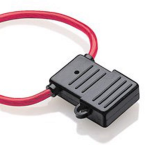Yes, I know it's an old thread, but I ended up here and so might someone else.
I have a single engine Rinker 260EC. No room to speak of for getting to the 90amp starter/solenoid mounted fuse.
As was stated, 90 amp fuse feeds a 50amp and 15 amp(violet/w red tracer). There is another flat fuse mounted to the fiberglass rail to the side of the starter. Not sure what it protects at the moment. I just got my boat back after 8 months, took it out once and all was fine. Second time, dead. Wouldn't crank and an no instruments. What I found was the nut on the primary red wire from battery at the solenoid was loose. The 90amp fuse was blown and the 15amp inline fuse (just behind the 50amp CB and the slave solenoid).
My questions:
1. Is there a reason to mount the 90amp to the solenoid? I'm thinking that the copper plate would conduct heat to the internal fuse element, causing it to fail from heat from the starter/solenoid. Just a guess.
2. If it's not there as a thermal protection for the starter/solenoid, can I move it somewhere else, so it's easy to get to when it blows (and I'm out in the Gulf and there's as bad storm coming......)?
3. No one ever answered the question. What part of the electrical system is at risk if you don't use the 90amp fuse? If it's not mounted to the starter/solenoid, it can't protect the starter from overheating. Once it blows, the engine will shut down and you won't be able to crank or start. From what I see it feeds the 50amp, a 15amp(vio/red) gauges, ignition, and starter circuit. I didn't find anything that was not protected by a lower value fuse or CB. Which points me back to protecting the starter/solenoid from overheating.
I really think that it's there to protect the starter/solenoid from overheating. What a really dumb-ass setup. Dead in the water until you crawl down in the engine compartment to replace/remove the fuse.
Writing this post helped me decided what needs to be done. I'll use the fuse so it's there to protect the starter/solenoid, but I'm going to run wires that will allow me give me a second circuit fuse (that I will have to manually take care of), THAT I CAN GET TO IN A HURRY!!!!!
I have a single engine Rinker 260EC. No room to speak of for getting to the 90amp starter/solenoid mounted fuse.
As was stated, 90 amp fuse feeds a 50amp and 15 amp(violet/w red tracer). There is another flat fuse mounted to the fiberglass rail to the side of the starter. Not sure what it protects at the moment. I just got my boat back after 8 months, took it out once and all was fine. Second time, dead. Wouldn't crank and an no instruments. What I found was the nut on the primary red wire from battery at the solenoid was loose. The 90amp fuse was blown and the 15amp inline fuse (just behind the 50amp CB and the slave solenoid).
My questions:
1. Is there a reason to mount the 90amp to the solenoid? I'm thinking that the copper plate would conduct heat to the internal fuse element, causing it to fail from heat from the starter/solenoid. Just a guess.
2. If it's not there as a thermal protection for the starter/solenoid, can I move it somewhere else, so it's easy to get to when it blows (and I'm out in the Gulf and there's as bad storm coming......)?
3. No one ever answered the question. What part of the electrical system is at risk if you don't use the 90amp fuse? If it's not mounted to the starter/solenoid, it can't protect the starter from overheating. Once it blows, the engine will shut down and you won't be able to crank or start. From what I see it feeds the 50amp, a 15amp(vio/red) gauges, ignition, and starter circuit. I didn't find anything that was not protected by a lower value fuse or CB. Which points me back to protecting the starter/solenoid from overheating.
I really think that it's there to protect the starter/solenoid from overheating. What a really dumb-ass setup. Dead in the water until you crawl down in the engine compartment to replace/remove the fuse.
Writing this post helped me decided what needs to be done. I'll use the fuse so it's there to protect the starter/solenoid, but I'm going to run wires that will allow me give me a second circuit fuse (that I will have to manually take care of), THAT I CAN GET TO IN A HURRY!!!!!





















